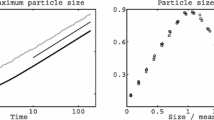Abstract
We consider the statistics of the areas enclosed by domain boundaries (‘hulls’) during the curvature-driven coarsening dynamics of a two-dimensional nonconserved scalar field from a disordered initial state. We show that the number of hulls per unit area, n h (A, t)dA, with enclosed area in the range (A,A + dA), is described, for large time t, by the scaling form n h (A, t) = 2c h /(A + λ h t)2, demonstrating the validity of dynamical scaling in this system. Here \( c_h = {1 \mathord{\left/ {\vphantom {1 8}} \right. \kern-\nulldelimiterspace} 8}\pi \sqrt 3 \) is a universal constant associated with the enclosed area distribution of percolation hulls at the percolation threshold, and λ h is a material parameter. The distribution of domain areas, n d (A, t), is apparently very similar to that of hull areas up to very large values of A/λ h t. Identical forms are obtained for coarsening from a critical initial state, but with c h replaced by c h /2. The similarity of the two distributions (of areas enclosed by hulls, and of domain areas) is accounted for by the smallness of c h . By applying a ‘mean-field’ type of approximation we obtain the form n d (A, t) ≃ 2c d [λ d (t+t 0)]τ−2/[A+λ d (t+t 0)]τ, where t 0 is a microscopic timescale and τ = 187/91 ≃ 2.055, for a disordered initial state, and a similar result for a critical initial state but with c d → c d /2 and τ → τ c = 379/187 ≃ 2.027. We also find that c d = c h + O(c 2 h ) and λ d = λ h (1 + O(c h )). These predictions are checked by extensive numerical simulations and found to be in good agreement with the data.
Similar content being viewed by others
References
A.J. Bray, Adv. Phys. 43, 357 (1994)
J.J. Arenzon, A.J. Bray, L.F. Cugliandolo, A. Sicilia, Phys. Rev. Lett. 98, 145701 (2007)
A. Sicilia, J.J. Arenzon, A.J. Bray, L.F. Cugliandolo, Phys. Rev. E 76, 061116 (2007)
P.C. Hohenberg, B.I. Halperin, Rev. Mod. Phys. 49, 435 (1977)
S.M. Allen, J.W. Cahn, Acta Metall. 27, 1085 (1979)
A. Weinrib, Phys. Rev. B 26, 1352 (1982) and references therein; J. Kalda, Phys. Rev. E 64, 020101(R)
J. Cardy, R.M. Ziff, J. Stat. Phys. 110, 1 (2003)
D. Stauffer, A. Aharony, Introduction to percolation theory, 2nd edn. (Taylor & Francis, London, 1994)
C. Vanderzande, A.L. Stella, J. Phys. A 22, L445 (1989)
N. Mason, A.N. Pargellis, B. Yurke, Phys. Rev. Lett. 70, 190 (1993)
Author information
Authors and Affiliations
Corresponding author
Rights and permissions
About this article
Cite this article
Arenzon, J.J., Bray, A.J., Cugliandolo, L.F. et al. Exact results for two-dimensional coarsening. Eur. Phys. J. B 64, 403–407 (2008). https://doi.org/10.1140/epjb/e2008-00020-6
Received:
Published:
Issue Date:
DOI: https://doi.org/10.1140/epjb/e2008-00020-6




